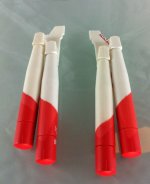If you are interested in old computers, you probably also know that monitors, keyboards and other parts yellow over time. These parts are made of ABS plastic, where ABS stands for "acrylonitrile butadiene styrene." In addition, there are fire retardants added to plastics. These are, among other things the added chemicals which make plastic eventually turn yellow, but other factors such as oxidation are also involved.
It's not everyone who collects old computers that like this discoloration. In 2008, a number of professionals in various fields set out to find a solution to this problem. There was a desire for a treatment which could remove yellowing, but which was also not deleterious to the plastic material. The result was Retro Bright (read more about RetrObright's story here).
Retro Bright is not a commercial product, but a home made gel. The gel is composed of hydrogen peroxide (H2O2 / hydrogen peroxide), xanthan gum (thickening agent), glycerine, and detergents. Hydrogen peroxide is commonly known from hair bleaching products. Detergent is added to the mixture because the substance tetra acetyl ethylene diamine (TAED) serves as a catalyst in the chemical process that takes place when the gel is applied to the yellowed plastic. Retro Bright is not a product recommended by conservators since there are currently no studies available which detail the long term effects.
It should be emphasized that Retro Bright is not something you should begin to experiment with at home in the kitchen without first having taken several precautions. Hydrogen peroxide is corrosive and can cause blindness if you get the solution in your eyes.
This week Yvonne Shashoua and myself have been testing the effects of RetrObright, and whether one can use it to rinse other types of plastic. The selected plastic materials are the ones we've used throughout the POPART (link) project, including polymethylmetakrylat (PMMA), polyvinylchloride (PVC), polyethylene, polystyrene, and cellulose acetate. Because Retro Bright is a mixed product, we decided also to test the pure solutions of hydrogen peroxide and detergents separately.
Our experiments showed that it definitely is not recommendable to use Retro Bright or hydrogen peroxide on the plastics we examined. As can be seen in photographs taken through the microscope, there was an etching of the surface, which was also visible with the naked eye. After the treatment of polymethylmetakrylat (PMMA) with hydrogen peroxide one could see a distinct cracking in the area where the solution had been applied. Polyvinyl chloride (PVC) on the other hand has faded, and the photograph shows how the soapy gel has etched a bubble-like pattern in the material's surface.
(images)
PMMA treated with hydrogen peroxide (25 x magnification)
PVC treated with Retro Bright (25 x magnification)
Although Retro Bright and hydrogen peroxide did not leave visible traces on all the materials we tested, we could nevertheless in all cases note a change in contact angle. This is an additional indication that the material surface tension has been changed as a result of treatment.

